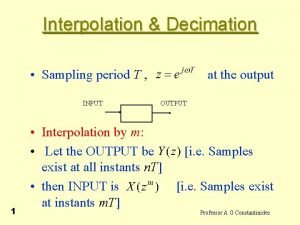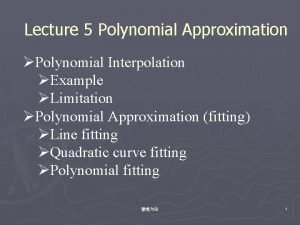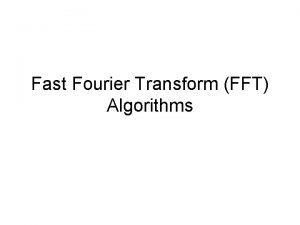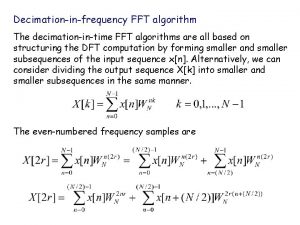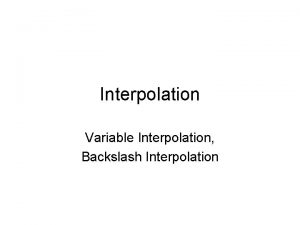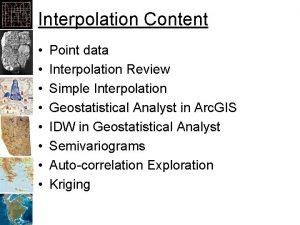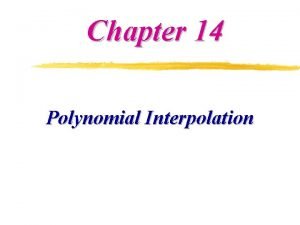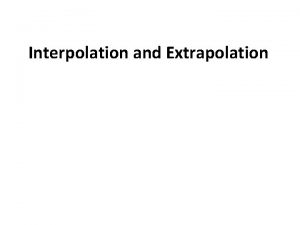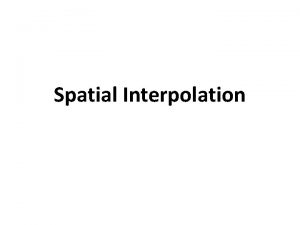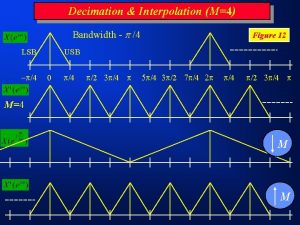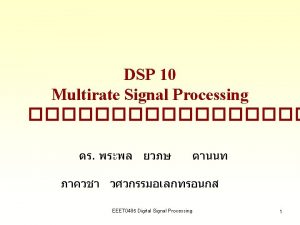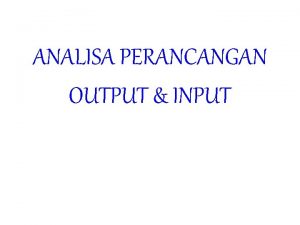Interpolation Decimation Sampling period T at the output

















![Polyphase Decomposition The Decomposition • Consider an arbitrary sequence {x[n]} with a z-transform X(z) Polyphase Decomposition The Decomposition • Consider an arbitrary sequence {x[n]} with a z-transform X(z)](https://slidetodoc.com/presentation_image_h/b5730a332f5443dfdc938d75764aa06d/image-18.jpg)

![Polyphase Decomposition • The relation between the subsequences and the original sequence {x[n]} are Polyphase Decomposition • The relation between the subsequences and the original sequence {x[n]} are](https://slidetodoc.com/presentation_image_h/b5730a332f5443dfdc938d75764aa06d/image-20.jpg)












- Slides: 32

Interpolation & Decimation • Sampling period T , at the output INPUT 1 OUTPUT • Interpolation by m: • Let the OUTPUT be [i. e. Samples exist at all instants n. T] • then INPUT is [i. e. Samples exist at instants m. T] Professor A G Constantinides

Interpolation & Decimation • Let Digital Filter transfer function be then • Hence is of the form i. e. its impulse response exists at the instants m. T. • Write 2 Professor A G Constantinides

Interpolation & Decimation • Or • Where • So that 3 Professor A G Constantinides

Interpolation & Decimation • Hence the structure may be realised as INPUT + OUTPUT Samples across here are phased by T secs. i. e. they do not interact in the adder. Can be replaced by a commutator switch. 4 Professor A G Constantinides

Interpolation & Decimation • Hence Commutator INPUT OUTPUT 5 Professor A G Constantinides

Interpolation & Decimation • Decimation by m: • Let Input be (i. e. Samples exist at all instants n. T) • Let Output be (i. e. Samples exist at instants m. T) • With digital filter transfer function we have 6 Professor A G Constantinides

Interpolation & Decimation • Set • And • Where in both expressions the subsequences are constructed as earlier. Then 7 Professor A G Constantinides

Interpolation & Decimation • Any products that have powers of less than m do not contribute to , as this is required to be a function of . • Therefore we retain the products 8 Professor A G Constantinides

Interpolation & Decimation • The structure realising this is Commutator INPUT 9 + OUTPUT Professor A G Constantinides

Interpolation & Decimation • For FIR filters why Downsample and then Upsample? LOW PASS LENGTH N #MULT/ACC DOWNSAMPLE M: 1 LOW PASS UPSAMPLE 1: M LOW PASS LENGTH N #MULT/ACC TOTAL #MULT/ACC 10 Professor A G Constantinides

Interpolation & Decimation • A very useful FIR transfer function special case is for : N odd, symmetric • with additional constraints on to be zero at the points shown in the figure. 11 Professor A G Constantinides

Interpolation & Decimation • For the impulse response shown • The amplitude response is then given • In general 12 Professor A G Constantinides

Interpolation & Decimation • Now consider • Then 13 Professor A G Constantinides

Interpolation & Decimation • Hence • Also • Or • For a normalised response 14 Professor A G Constantinides

Interpolation & Decimation • Thus • The shifted response is useful 15 Professor A G Constantinides

Design of Decimator and Interpolator • Example Develop the specs suitable for the design of a decimator to reduce the sampling rate of a signal from 12 k. Hz to 400 Hz • The desired down-sampling factor is therefore M = 30 as shown below 16 Professor A G Constantinides

Multistage Design of Decimator and Interpolator • Specifications for the decimation filter H(z) are assumed to be as follows: , 17 Professor A G Constantinides
![Polyphase Decomposition The Decomposition Consider an arbitrary sequence xn with a ztransform Xz Polyphase Decomposition The Decomposition • Consider an arbitrary sequence {x[n]} with a z-transform X(z)](https://slidetodoc.com/presentation_image_h/b5730a332f5443dfdc938d75764aa06d/image-18.jpg)
Polyphase Decomposition The Decomposition • Consider an arbitrary sequence {x[n]} with a z-transform X(z) given by • We can rewrite X(z) as where 18 Professor A G Constantinides

Polyphase Decomposition • The subsequences are called the polyphase components of the parent sequence {x[n]} • The functions , given by the z -transforms of , are called the polyphase components of X(z) 19 Professor A G Constantinides
![Polyphase Decomposition The relation between the subsequences and the original sequence xn are Polyphase Decomposition • The relation between the subsequences and the original sequence {x[n]} are](https://slidetodoc.com/presentation_image_h/b5730a332f5443dfdc938d75764aa06d/image-20.jpg)
Polyphase Decomposition • The relation between the subsequences and the original sequence {x[n]} are given by • In matrix form we can write 20 Professor A G Constantinides

Polyphase Decomposition • A multirate structural interpretation of the polyphase decomposition is given below 21 Professor A G Constantinides

Polyphase Decomposition • The polyphase decomposition of an FIR transfer function can be carried out by inspection • For example, consider a length-9 FIR transfer function: 22 Professor A G Constantinides

Polyphase Decomposition • Its 4 -branch polyphase decomposition is given by where 23 Professor A G Constantinides

Polyphase Decomposition • The polyphase decomposition of an IIR transfer function H(z) = P(z)/D(z) is not that straight forward • One way to arrive at an M-branch polyphase decomposition of H(z) is to express it in the form by multiplying P(z) and D(z) with an appropriately chosen polynomial and then apply an M-branch polyphase decomposition to 24 Professor A G Constantinides

Polyphase Decomposition • Example - Consider • To obtain a 2 -band polyphase decomposition we rewrite H(z) as • Therefore, where 25 Professor A G Constantinides

Polyphase Decomposition • The above approach increases the overall order and complexity of H(z) • However, when used in certain multirate structures, the approach may result in a more computationally efficient structure • An alternative more attractive approach is discussed in the following example 26 Professor A G Constantinides

Polyphase Decomposition • Example - Consider the transfer function of a 5 -th order Butterworth lowpass filter with a 3 -d. B cutoff frequency at 0. 5 p: • It is easy to show that H(z) can be expressed as 27 Professor A G Constantinides

Polyphase Decomposition • Therefore H(z) can be expressed as where 28 Professor A G Constantinides

Polyphase Decomposition • In the above polyphase decomposition, branch transfer functions are stable allpass functions (proposed by Constantinides) • Moreover, the decomposition has not increased the order of the overall transfer function H(z) 29 Professor A G Constantinides

FIR Filter Structures Based on Polyphase Decomposition • We shall demonstrate later that a parallel realization of an FIR transfer function H(z) based on the polyphase decomposition can often result in computationally efficient multirate structures • Consider the M-branch Type I polyphase decomposition of H(z): 30 Professor A G Constantinides

FIR Filter Structures Based on Polyphase Decomposition • A direct realization of H(z) based on the Type I polyphase decomposition is shown below 31 Professor A G Constantinides

FIR Filter Structures Based on Polyphase Decomposition • The transpose of the Type I polyphase FIR filter structure is indicated below 32 Professor A G Constantinides
 Interpolation and decimation
Interpolation and decimation Spline interpolation vs polynomial interpolation
Spline interpolation vs polynomial interpolation Interolation
Interolation Discrete fourier transform formula
Discrete fourier transform formula Fft decimation in frequency
Fft decimation in frequency Probability vs non probability sampling
Probability vs non probability sampling Cluster vs stratified sampling
Cluster vs stratified sampling Cluster sampling vs stratified random sampling
Cluster sampling vs stratified random sampling Snowball sampling
Snowball sampling Stratified vs clustered
Stratified vs clustered Natural sampling vs flat top sampling
Natural sampling vs flat top sampling Contoh laporan event sampling
Contoh laporan event sampling Cynthia lightfoot
Cynthia lightfoot Approaches to child development
Approaches to child development Stability period vs measurement period
Stability period vs measurement period Absolute refractory period and relative refractory period
Absolute refractory period and relative refractory period 1750 music
1750 music Trustee period and royal period
Trustee period and royal period Critical period vs sensitive period
Critical period vs sensitive period Is hyperpolarization the same as refractory period
Is hyperpolarization the same as refractory period 12 neutrons, metallic, 11 electrons
12 neutrons, metallic, 11 electrons Ce vs ad
Ce vs ad Critical vs sensitive period examples
Critical vs sensitive period examples Period of activism meaning
Period of activism meaning Cong thức tính động năng
Cong thức tính động năng Thế nào là mạng điện lắp đặt kiểu nổi
Thế nào là mạng điện lắp đặt kiểu nổi Hát kết hợp bộ gõ cơ thể
Hát kết hợp bộ gõ cơ thể Các loại đột biến cấu trúc nhiễm sắc thể
Các loại đột biến cấu trúc nhiễm sắc thể Vẽ hình chiếu đứng bằng cạnh của vật thể
Vẽ hình chiếu đứng bằng cạnh của vật thể độ dài liên kết
độ dài liên kết Chó sói
Chó sói Các môn thể thao bắt đầu bằng tiếng chạy
Các môn thể thao bắt đầu bằng tiếng chạy Thiếu nhi thế giới liên hoan
Thiếu nhi thế giới liên hoan
